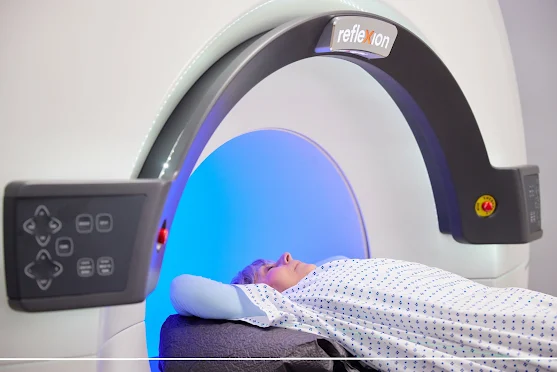Radiation therapy has long been a crucial component in the treatment of cancer, but recent advancements have led to the emergence of groundbreaking techniques that redefine how we approach cancer treatment. One such innovation is RefleXion radiotherapy, which has shown promising results in its initial application on a cancer patient. In this article, we delve into the world of RefleXion radiotherapy, its significance, benefits, and the potential it holds for transforming the landscape of cancer care.
A New Era in Cancer Treatment
The field of oncology has witnessed remarkable progress over the years, and the introduction of RefleXion radiotherapy marks yet another significant milestone. This revolutionary technique combines the power of traditional radiation therapy with cutting-edge technology, promising to revolutionize the way we approach cancer treatment.
Understanding RefleXion Radiotherapy
The Principle Behind RefleXion Radiotherapy
At its core, RefleXion radiotherapy operates on a simple yet ingenious principle – leveraging the tumor's own biological activity to guide the delivery of radiation. Unlike conventional methods that rely solely on anatomy, RefleXion radiotherapy takes advantage of the tumor's unique behavior, allowing for highly precise targeting.
Targeted Cancer Treatment with Precision
RefleXion radiotherapy utilizes emission tomography (PET) scans to track the tumor's movement and metabolic activity in real time. This real-time feedback enables oncologists to adapt the radiation delivery with exceptional accuracy, ensuring that the tumor receives the maximum dose while sparing healthy surrounding tissues.
Pioneering Patient Treatment
A Landmark Moment: Treating the First Cancer Patient
In a historic breakthrough, the first cancer patient was successfully treated using RefleXion radiotherapy. This achievement not only signifies a step forward in medical science but also instills hope for patients with challenging cases. The treatment's precision and adaptability showcased its potential to address previously unmet needs in cancer care.
Personalized Approach and Enhanced Effectiveness
RefleXion radiotherapy's ability to personalize treatment based on real-time information paves the way for enhanced effectiveness. Each patient's tumor is unique, and by continuously adjusting the treatment plan, RefleXion radiotherapy maximizes its impact, even on tumors that were once considered difficult to treat.
Advantages of RefleXion Radiotherapy
Minimizing Collateral Damage to Healthy Tissues
One of the standout advantages of RefleXion radiotherapy is its capacity to minimize collateral damage to healthy tissues. The precise targeting based on real-time feedback significantly reduces radiation exposure to non-cancerous areas, thereby minimizing potential side effects.
Real-time Adaptive Therapy for Moving Tumors
Tumors located in areas prone to movement, such as the lungs, can pose challenges for conventional radiation therapy. RefleXion radiotherapy's adaptability to such movements ensures that the tumor remains within the treatment field, increasing the therapy's overall effectiveness.
Potential Impact on Cancer Care
Redefining Possibilities for Inoperable Cancers
For patients with inoperable tumors, RefleXion radiotherapy opens new possibilities. Its accuracy and adaptability make it an attractive option for those who were once deemed untreatable, offering hope and a chance at improved outcomes.
Expanding Treatment Options for Advanced Stages
Advanced-stage cancer patients often face limited treatment options. RefleXion radiotherapy's potential to deliver targeted radiation even to complex tumors provides a ray of hope for individuals at later stages of the disease.
The Future of Cancer Treatment: RefleXion's Role
Integrating Artificial Intelligence for Improved Targeting
The future evolution of RefleXion radiotherapy involves the integration of artificial intelligence (AI) to further refine targeting. AI algorithms can analyze PET scan data in real time, enhancing precision and adapting treatment strategies in ways previously unachievable.
Collaborative Efforts in Advancing Radiotherapy
The success of RefleXion radiotherapy exemplifies the power of collaboration between medical experts, engineers, and technology developers. This synergy has the potential to drive even more innovations in the field of radiotherapy, ultimately benefiting patients worldwide.
Conclusion: A Promising Step Forward in Oncology
The landmark treatment of the first cancer patient using RefleXion radiotherapy underscores its transformative potential. As this technique continues to evolve and make its way into mainstream oncology, patients can look forward to more effective and tailored cancer treatments, offering renewed hope and improved quality of life.
FAQs
Q1: How does RefleXion radiotherapy differ from traditional radiation therapy?
A1: RefleXion radiotherapy uses real-time feedback and the tumor's biological activity to guide radiation delivery, ensuring precision and minimizing collateral damage.
Q2: Can RefleXion radiotherapy treat all types of cancer?
A2: While it holds promise for a wide range of cancers, its application may vary depending on the type and location of the tumor.
Q3: Is RefleXion radiotherapy safe?
A3: Yes, RefleXion radiotherapy prioritizes safety by minimizing radiation exposure to healthy tissues, thereby reducing the risk of side effects.
Q4: How is artificial intelligence integrated into RefleXion radiotherapy?
A4: Artificial intelligence analyzes real-time PET scan data to enhance targeting accuracy and adapt treatment strategies.



